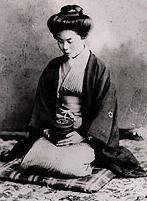Chizuko Mifune

Chizuko Mifune (御船 千鶴子, Mifune Chizuko, 17 July 1886 – 19 January 1911) was a self-proclaimed clairvoyant during the late Meiji period in Japan.
Early years
Born in Kumamoto Prefecture, Mifune was married in 1908. It has been stated that she was deeply religious and, at times, was hypnotized by her brother-in-law. She allegedly developed her powers at the age of 24 by breathing and meditation exercises.[1][2]
Fukurai

Tomokichi Fukurai, Assistant Professor of Psychology at the University of Tokyo, was deeply interested in the supernatural and desired to validate extra-sensory perception. Fukarai's supernatural interests were heavily criticized by his colleagues, but he was convinced Mifune's powers were genuine when he privately tested her in April 1910. A second, public test was conducted by Tokyo University president Baron Yamakawa Kenjirō on 15 September 1910. She appeared to read messages written inside hidden envelopes, however, when these messages turned out to be not from Yamakawa but from Fukurai, she was widely seen as a charlatan and heavily criticized by the press.[1][2]
A modern researcher, Rodger Anderson has noted that the experiments were not properly controlled as Mifune "was often left alone with the test envelope, or insisted on turning her back to witnesses when attempting to psychically probe its contents."[3]
Death
Four months later, in 19 January 1911, Mifune committed suicide at the age of 24 by ingesting poison.[1][2]
Influences
Japanese horror filmmakers of Yogen and Ringu reportedly used Mifune as the inspiration behind the character Shizuko Yamamura, the mother of Ringu antagonist Sadako Yamamura.
References
- ^ a b c Kristen Lacefield (1 April 2013). The Scary Screen: Media Anxiety in the Ring. Ashgate Publishing, Ltd. p. 34. ISBN 978-1-4094-7619-1.
- ^ a b c David B. Baker (13 January 2012). The Oxford Handbook of the History of Psychology: Global Perspectives. Oxford University Press. pp. 354–. ISBN 978-0-19-536655-6.
- ^ Anderson, Rodger. (2006). Psychics, Sensitives and Somnambules: A Biographical Dictionary with Bibliographies. McFarland & Company. p. 65. ISBN 978-0-7864-2770-3
External links
- Factual Basis Behind The Ring, Ringworld.com, accessed February 23, 2006
- [1] Factual Basis Behind The Ring, Curse of the Ring, accessed June 26, 2012
- Fukurai Institute of Psychology
